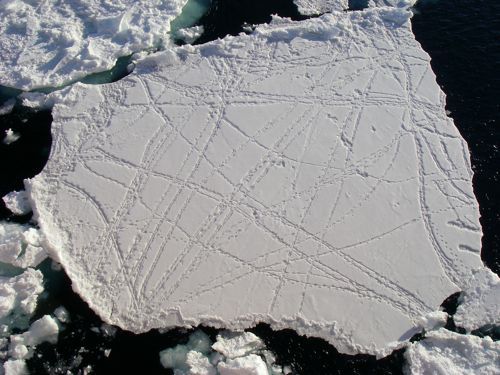McMurdo Sound Ice StationAs we approached Ross Island at the far western edge of the Ross Sea Polynya, we were greeted by amazing views of the 4 volcanic peaks of Ross Island. This was the first real land we had seen in over a month and it marked the beginning of our last week on the Oden. After 12 hours of icebreaking we established our last and longest sea ice station where we stayed for over 2 days. During that time all of the science teams worked to collect and analyze their last samples. It was also my last chance to go out on the ice with the seal research team. This time I was part of a 5-person group as we worked with the biggest Weddell seals of the entire trip. I was even promoted to be one of the 2 net handlers who actually captured each of the 5 seals. The ice of McMurdo Sound is very different than the ice of the Amundsen Sea. Protected by the nearby land, the ice does not move as much and so the floes were much less jumbled up and we walked for miles over almost flat surfaces. At 77˚S it is also very dry and windy so there is only about 1 inch of snow on top of the ice which made walking very easy. Standing on the ice it appeared as if we were on a 30 mile wide flat valley with the volcanoes of Ross Island on one side and the Trans Antarctic Mountains on the other. As the sun makes its slow, angled circle in the sky around us, the colors on the ice and the mountains is constantly changing.
This is an Amazing IcebreakerAn icebreaker is a special purpose ship or boat designed to move and navigate through ice-covered waters.
After living here for 6 weeks I am still stunned by what this ship can do in the hands of its skilled crew. As the Oden makes its way south through McMurdo Sound, most of the way it is cutting through a rather flat sheet of 1-meter thick (3 feet) sea ice. The captain is only using 3 of the 4 main engines at about 60% power and yet we are moving forward at a steady 8 mph. As we move forward, the ship pumps 12,000 cubic meters per hour of seawater onto the ice in front of the ship to make it easier for the ship to slide up onto. If we stop for a few minutes it creates a swimming pool of water on top of the ice. The ice is pushed under the bow and forced out to the side of the mighty ship. As we enter the thicker ice the Oden gathers speed and rams the ice, sliding up on top of it. You feel the ship tilt up and then the bow crushes down through 2-3 meters of sea ice. Blocks of ice the size of my Pontiac Vibe are pushed under the ship and then burst to the surface in the channel behind us.
Special Notes: Apologies and Coming Attractions
Periodically, we have struggled to use the satellite phone for email communication. It has made it very difficult to send my journal posts out to all of you and even to receive and send posts to the Ask The Team forum. Thank you all for your patience. As a reward, I am promising the most amazing videos of the entire trip are yet to come. Watch for "Flying Penguins" and "Antarctic Minke Whales".
You will not be disappointed.







Comments